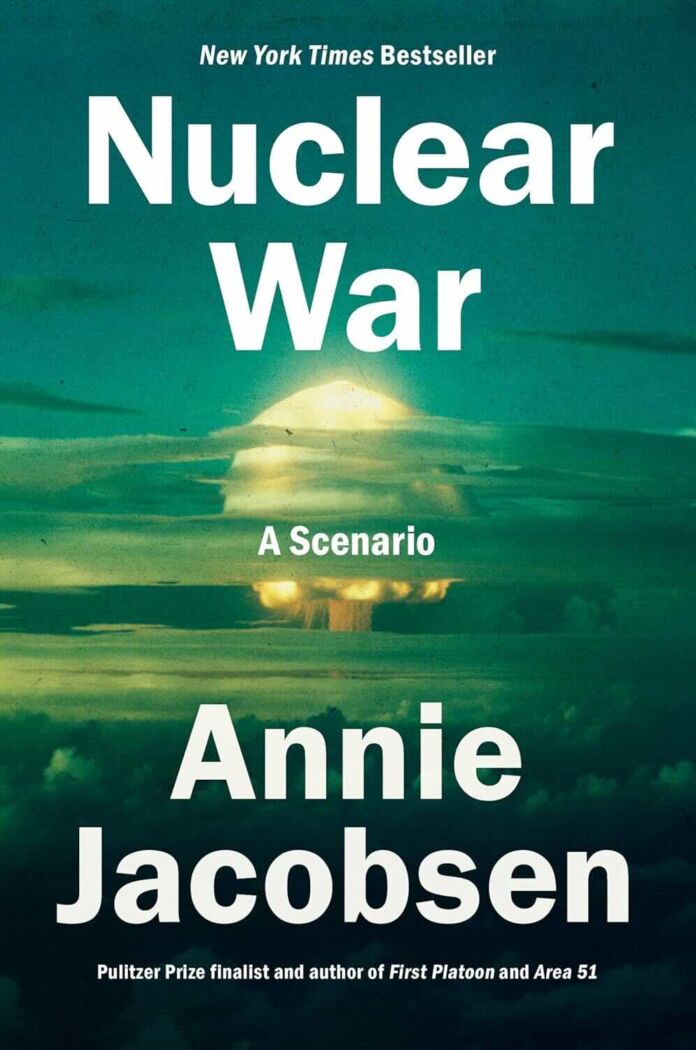A Ticking Clock Towards Catastrophe
In the annals of human history, few technological developments have cast as long and ominous a shadow as nuclear weapons. Their very existence presents an existential threat to civilization itself, a Sword of Damocles perpetually suspended over humanity’s collective head. It is into this realm of potential annihilation that acclaimed investigative journalist Annie Jacobsen plunges headlong in her latest work, “Nuclear War: A Scenario.”
With the meticulous attention to detail and gripping narrative style that have become her hallmarks, Jacobsen constructs a harrowing minute-by-minute account of how a nuclear exchange might unfold. Drawing on extensive interviews with military officials, weapons designers, and policy experts, she paints a vivid and terrifying picture of the intricate systems designed to prevent such a catastrophe – and how quickly they could unravel.
A Masterclass in Investigative Journalism
Jacobsen, a Pulitzer Prize finalist, brings her considerable talents as a researcher and storyteller to bear on this most consequential of subjects. As in her previous works like “Area 51” and “Operation Paperclip,” she demonstrates an uncanny ability to gain access to secretive government agencies and coax revealing information from tight-lipped sources.
The result is a tour de force of reporting that takes readers inside nuclear command bunkers, onto Ohio-class submarines bristling with ballistic missiles, and into the mindset of military planners tasked with contemplating the unthinkable. Jacobsen’s prose crackles with urgency as she walks us through the heart-stopping minutes between initial launch detection and potential retaliation.
A Scenario All Too Real
At the core of the book is a non-fictional and meticulously researched scenario of a nuclear strike against the United States and the resulting chaos. Jacobsen’s narrative toggles between a gripping blow-by-blow account of the unfolding crisis and deeply researched historical context on the development of nuclear strategy and technology.
This structure allows her to seamlessly blend storytelling and reportage, creating a work that is simultaneously a pulse-pounding thriller and a sobering examination of real-world nuclear risks. Readers will find themselves white-knuckled as they follow the split-second decisions that could mean the difference between limited conflict and all-out Armageddon.
Key Insights and Revelations
Among the book’s most startling revelations:
- The shockingly brief window—just minutes—that U.S. leadership would have to assess a potential attack and decide on a response
- The vulnerability of early warning systems to false alarms and misinterpretation
- The existence of automated “Dead Hand” systems designed to ensure retaliatory strikes even if leadership is incapacitated
- The devastating long-term consequences of even a “limited” nuclear exchange, including global cooling and widespread famine
Jacobsen’s reporting shines a spotlight on the razor’s edge separating us from potential catastrophe. She details how seemingly minor technical glitches or moments of human error could spiral into full-blown nuclear war with terrifying speed.
A Call to Attention and Action
While “Nuclear War: A Scenario” makes for undeniably grim reading, Jacobsen’s purpose is not merely to frighten. Rather, she seeks to shake readers out of complacency and spark renewed public engagement with nuclear policy issues.
In an era when “mutually assured destruction” can feel like a relic of the Cold War, Jacobsen forcefully argues that the threat of nuclear conflict remains all too real. From simmering tensions with North Korea to the potential for regional conflicts to escalate, she outlines a host of scenarios that could lead to nuclear weapons use.
Echoes of Past Works
Readers familiar with classic works on nuclear strategy like John Hersey’s “Hiroshima” or Jonathan Schell’s “The Fate of the Earth” will find clear echoes in Jacobsen’s approach. Like those authors, she seeks to render the unthinkable thinkable – not to normalize it, but to galvanize action to prevent it.
Jacobsen’s scenario bears comparison to other fictionalized accounts of nuclear war like Nevil Shute’s “On the Beach” or the film “The Day After.” Yet her journalist’s eye for detail and commitment to factual accuracy elevate the work beyond mere speculation.
A Critique of Nuclear Deterrence
Running throughout the book is an implicit critique of the doctrine of nuclear deterrence that has underpinned global security strategy for decades. Jacobsen’s minute-by-minute breakdown of a crisis scenario exposes the myriad ways this delicate balance could collapse.
She raises profound questions about the wisdom of maintaining vast nuclear arsenals on hair-trigger alert. Can human decision-makers truly be trusted to make rational choices in the pressure-cooker environment of a potential nuclear exchange? Are the risks of accidental launch or misinterpreted warning signs simply too great?
The Human Element
One of the book’s great strengths is Jacobsen’s focus on the human beings at the center of the nuclear command structure. From submarine crews to missile silo operators to the president him/herself, she never lets us forget that fallible humans are ultimately responsible for these world-ending weapons.
Her interviews with military personnel tasked with nuclear responsibilities are particularly revealing. Many express a profound unease with the awesome destructive power at their fingertips, even as they remain committed to their duty.
A Work of Vital Importance
“Nuclear War: A Scenario” is not an easy read. Jacobsen’s vivid descriptions of the effects of nuclear weapons—from immediate blast damage to long-term radiation poisoning—are genuinely disturbing. Her account of how quickly and irreversibly events could spiral out of control is likely to leave readers unsettled.
Yet it is precisely this visceral impact that makes the book so important. By forcing us to confront the reality of what nuclear war would mean, Jacobsen performs a vital public service. In an age of renewed great power competition and fraying arms control agreements, her warning could not be more timely.
A Call for Renewed Engagement
Jacobsen concludes with a plea for renewed public and policymaker engagement with nuclear issues. She argues convincingly that the technical complexity of these weapons systems and the classified nature of much nuclear policy have led to dangerous public apathy.
By demystifying the command and control structures surrounding nuclear weapons, she hopes to empower citizens to ask hard questions of their leaders. What are the true costs and risks of maintaining our current nuclear posture? Are there better ways to ensure global security?
Final Thoughts: A Must-Read Wake-Up Call
“Nuclear War: A Scenario” is not for the faint of heart. Jacobsen’s unflinching examination of how quickly and completely our world could be destroyed is genuinely haunting. Yet it is also a work of profound importance, one that deserves the widest possible readership.
In forcing us to confront the unthinkable, Jacobsen reminds us of our shared stake in preventing it. She has produced a work that is equal parts gripping narrative and clarion call to action. For anyone concerned with the future of humanity, it is quite simply essential reading.
Who Should Read This Book
- Policymakers and military strategists grappling with nuclear deterrence challenges
- Students of international relations and security studies
- Citizens concerned about nuclear proliferation and arms control
- Anyone seeking to understand the stark realities of modern warfare
Jacobsen has once again demonstrated why she is one of our most vital investigative journalists. With “Nuclear War: A Scenario,” she has produced a work of lasting significance – one that may just help us step back from the nuclear brink.





